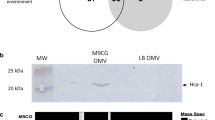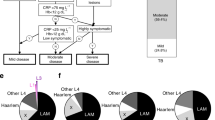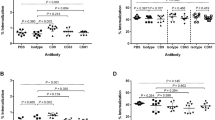Abstract
Coccidioides posadasii spherules stimulate macrophages to make cytokines via TLR-2 and Dectin-1. We used formalin-killed spherules and 1,3-β-glucan purified from spherules to stimulate elicited peritoneal macrophages and myeloid dendritic cells (mDCs) from susceptible (C57BL/6) and resistant (DBA/2) mouse strains. DBA/2 macrophages produced more TNF-α and IL-6 than macrophages from C57BL/6 mice, and the amount of TNF-α made was dependent on both TLR2 and Dectin-1. DCs from C57BL/6 mice made more IL-10 and less IL-23p19 and IL-12p70 than did DBA/2 DC. These responses were inhibited by a monoclonal antibody to Dectin-1. DBA/2 mice expressed full-length Dectin-1, whereas C57BL/6 mice spliced out exon 3, which encodes most of the stalk. RAW cells transduced to express the full-length Dectin-1 responded better to FKS than cells expressing truncated Dectin-1. We compared the isoform of Dectin-1 expressed by 34 C57BL/6 X DBA/2 recombinant inbred (BXD RI) lines with their susceptibility to Coccidioides immitis. In 25 of 34 RI lines susceptibility or resistance corresponded to short or full-length isoforms, respectively. These results suggest that alternative splicing of the Dectin-1 gene contributes to susceptibility of C57BL/6 mice to coccidioidomycosis, and affects the cytokine responses of macrophages and mDCs to spherules.
This is a preview of subscription content, access via your institution
Access options
Subscribe to this journal
Receive 6 digital issues and online access to articles
$119.00 per year
only $19.83 per issue
Buy this article
- Purchase on Springer Link
- Instant access to full article PDF
Prices may be subject to local taxes which are calculated during checkout







Similar content being viewed by others
References
Fisher MC, Koenig GL, White TJ, Taylor JW . Molecular and phenotypic description of Coccidioides posadasii sp. nov., previously recognized as the non-California population of Coccidioides immitis. Mycologia 2002; 94: 73–84.
Cox RA, Magee DM . Coccidioidomycosis: host response and vaccine development. Clin Microbiol Rev 2004; 17: 804–839.
Viriyakosol S, Fierer J, Brown GD, Kirkland TN . Innate immunity to the pathogenic fungus Coccidioides posadasii is dependent on toll-like receptor 2 and dectin 1. Infect Immun 2005; 73: 1553–1560.
Kellner EM, Orsborn KI, Siegel EM, Mandel MA, Orbach MJ, Galgiani JN . Coccidioides posadasii contains a single 1,3-B-glucan synthase gene that appears to be essential for growth. Eukaryotic Cell 2005; 4: 111–120.
Stevens DA, Levine HB, TenEyck DR . Dermal sensitivity to different doses of spherulin and coccidioidin. Chest 1974; 65: 530–533.
Drutz DJ, Catanzaro A . Coccidioidomycosis. Part I. Am Rev Respir Dis 1978; 117: 559–583.
Pappagianis D . Epidemiology of coccidioidomycosis. In: McGinnis MR (ed). Current Topics in Medical Mycology. Springer-Verlag: New York, 1988, pp 199–238.
Kirkland TN, Fierer J . Inbred mouse strains differ in resistance to lethal Coccidioides immitis infection. Infect Immun 1983; 40: 912–916.
Kirkland TN, Fierer J . Genetic control of resistance to Coccidioides immitis: a single gene that is expressed in spleen cells determines resistance. J Immunol 1985; 135: 548–552.
Cox RA, Kennell W, Boncyk L, Murphy JW . Induction and expression of cell-mediated immune responses in inbred mice infected with Coccidioides immitis. Infect Immun 1988; 56: 13–17.
Fierer J, Walls L, Wright F, Kirkland TN . Genes influencing resistance to Coccidioides immitis and the interleukin-10 response map to chromosomes 4 and 6 in mice. Infect Immun 1999; 67: 2916–2919.
Brown GD, Gordon S . A new receptor for β-glucans. Nature 2001; 413: 36–37.
Dennehy KM, Brown GD . The role of the β-glucan receptor Dectin-1 in control of fungal infection. J Leukoc Biol 2007; 82: 253–258.
Heinsbroek SEM, Taylor PR, Rosas M, Willment JA, Williams DL, Gordon S et al. Expression of functionally different Dectin-1 isoforms by murine macrophages. J Immunol 2006; 176: 5513–5518.
Ariizumi K, Shen G-L, Shikano S, Xu S, Ritter RI, Kumamoto T et al. Identification of a novel, dendritic cell-associated molecule, Dectin-1, by subtractive cDNA cloning. J Biol Chem 2000; 275: 20157–20167.
Willment JA, Marshall ASJ, Reid DM, Williams DL, Wong SYC, Gorder S et al. The human beta-glucan receptor is widely expressed and functionally equivalent to murine Dectin-1 on primary cells. Eur J Immunol 2005; 35: 1539–1547.
Brown GD . Dectin-1: a signalling non-TLR pattern-recognition receptor. Nat Rev Immunol 2006; 6: 33–43.
McCann F, Carmona E, Puri V, Pagano RE, Limper AH . Macrophage internalization of fungal B-glucans is not necessary for initiation of related inflammatory responses. Infect Immun 2005; 73: 6340–6349.
Saijo S, Fujikado N, Furuta T, Chung S-H, Kotaki H, Seki K et al. Dectin-1 is required for host defense against Pneumocystis carinii but not against Candida albicans. Nat Immunol 2007; 8: 39–46.
Taylor PR, Tsoni V, Willment JA, Dennehy KM, Rosas M, Findon H et al. Dectin-1 is required for B-glucan recognition and control of fungal infection. Nat Immunol 2007; 8: 31–38.
Steele C, Rapaka RR, Metz A, Pop SM, Williams DL, Gordon S et al. The beta-glucan receptor dectin-1 recognizes specific morphologies of Aspergillus fumigatus. PLoS Pathog 2005; 1: 42–54.
Magee DM, Cox RA . Roles of gamma interferon and interleukin-4 in genetically determined resistance to Coccidioides immitis. Infect Immun 1995; 63: 3514–3519.
Adachi Y, Ishii T, Ikeda Y, Hoshino A, Tamura H, Aketagawa J et al. Characterization of beta-glucan recognition site on C-type lectin, dectin 1. Infect Immun 2004; 72: 4159–4171.
Kato Y, Adachi Y, Ohno N . Contribution of N-linked oligosaccharides to the expression and functions of B-glucan receptor, dectin-1. Biol Pharmacol Bull 2006; 29: 1580–1586.
Yokota K, Takashima A, Bergstresser PR, Ariizumi K . Identification of a human homologue of the dendritic cell-associated C-type lectin-1, dectin-1. Gene 2001; 272: 51–60.
Willment JA, Gordon S, Brown GD . Characterization of the human beta-glucan receptor and its alternatively spliced isoforms. J Biol Chem 2001; 276: 43818–43823.
Fierer J . The role of IL-10 in genetic susceptibility to coccidioidomycosis on mice. Ann NY Acad Sci 2007; 1111: 236–244.
Huang Q, Liu D, Majewski P, Schulte LC, Korn JM, Young RA et al. The plasticity of dendritic cell responses to pathogens and their components. Science 2001; 294: 870–875.
Fierer J, Walls L, Eckmann L, Yamamoto T, Kirkland TN . Importance of interleukin-10 in genetic susceptibility of mice to Coccidioides immitis. Infect Immun 1998; 66: 4397–4402.
Jiménez MdP, Walls L, Fierer J . High levels of interleukin-10 impair resistance to pulmonary coccidioidomycosis in mice in part through control of nitric oxide synthase 2 expression. Infect Immun 2006; 74: 3387–3395.
Gut-Landman SL, Grob O, Robinson MJ, Osorio F, Slack EC, Tsoni SV et al. Syk- and CARD9-dependent coupling of innate immunity to the induction of T helper cells that produce interleukin 17. Nat Immunol; 8: 630–638.
Dennehy KM, Ferwerda G, Faro-Trindade I, Pys E, Willment JA, Taylor PR et al. Syk kinase is required for collaborative cytokine production induced through Dectin-1 and Toll-like receptors. Eur J Immunol 2008; 38: 500–506.
Harrington LE, Mangan PR, Weaver CT . Expanding the effector CD4 T-cell repertoire; the Th17 lineage. Curr Opin Immunol 2006; 18: 349–356.
Huang W, Na L, Fidel PL, Schwarzenberger P . Requirement of interleukin-17A for systemic anti-Candida albicans host defense in mice. J Infect Dis 2004; 190: 624–631.
Mayfield JA, Rine J . The genetic basis of variation in susceptibility to infection with Histoplasma capsulatum in the mouse. Genes Immun 2007; 8: 468–474.
Walch HA, Kalvoda A . Immunization of mice with induced mutants of Coccidioides immitis. I. Characterization of mutants and preliminary studies of their use as viable vaccines. Sabouraudia 1971; 9: 173–184.
Converse JL, Besemer AR . Nutrition of the parasitic phase of coccidioides immitis in a chemically defined liquid medium. J Bacteriol 1959; 78: 231–239.
Jiménez MdP, Restrepo A, Garcia LF, Cano LE . Separation of Paracoccidioides brasiliensis conidia through Percoli gradients. Med Mycol 2004; 42: 349–353.
Viriyakosol S, Mathison JC, Tobias PS, Kirkland TN . Structure–function analysis of CD14 as a soluble receptor. J Biol Chem 2000; 275: 3144–3149.
Ding AH, Nathan CF, Stuehr DJ . Release of reactive nitrogen intermediates and reactive oxygen intermediates from mouse peritoneal macrophages: comparison of activating cytokines and evidence for independent production. J Immunol 1988; 141: 2407–2412.
Datta SK, Okamoto S, Hayashi T, Shin SS, Mihajlov I, Fermin A et al. Vaccination with irradiated Listeria induces protective T cell immunity. Immunity 2006; 25: 1–10.
Dionne SO, Podany AB, Ruiz YW, Ampel NM, Galgiani JN, Lake DF . Spherules derived from Coccidioides posadasii promote human dendrite cell maturation and activation. Infect Immun 2006; 74: 2415–2422.
Acknowledgements
This work was supported in part by Merit Review Grants from the Veterans Administration (JF and TK). Dr Jiménez-A was supported by Convenio Especial de Cooperación No. 067-2002 Suscrito entre Colciencias-Icetex, Colombia. This work was performed as part to fulfill her requirements as a PhD student of the Medical Sciences PhD program of UPB-CIB-CES, Medellin, Colombia. We thank Dr John Galgiani (University of Arizona) for the generous gift of 96 h (young) spherules.
Author information
Authors and Affiliations
Corresponding author
Rights and permissions
About this article
Cite this article
del Pilar Jiménez-A, M., Viriyakosol, S., Walls, L. et al. Susceptibility to Coccidioides species in C57BL/6 mice is associated with expression of a truncated splice variant of Dectin-1 (Clec7a). Genes Immun 9, 338–348 (2008). https://doi.org/10.1038/gene.2008.23
Received:
Revised:
Accepted:
Published:
Issue Date:
DOI: https://doi.org/10.1038/gene.2008.23
Keywords
This article is cited by
-
Call for a California Coccidioidomycosis Consortium to Face the Top Ten Challenges Posed by a Recalcitrant Regional Disease
Mycopathologia (2015)
-
Anti-inflammatory and Immunomodulatory Effect of an Extract of Coccidioides posadasii in Experimental Arthritis
Mycopathologia (2013)
-
De novo reconstruction of the Toxoplasma gondii transcriptome improves on the current genome annotation and reveals alternatively spliced transcripts and putative long non-coding RNAs
BMC Genomics (2012)
-
Dectin-1 isoforms contribute to distinct Th1/Th17 cell activation in mucosal candidiasis
Cellular & Molecular Immunology (2012)
-
In vivo trafficking and immunostimulatory potential of an intranasally-administered primary dendritic cell-based vaccine
BMC Immunology (2010)



